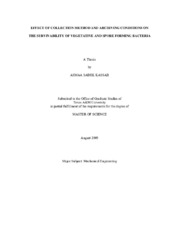| dc.description.abstract | To ensure effective detection of bio-particles, it is crucial to understand the
effects of collection method and archiving conditions on the survivability of bioaerosols,
consequently, the survivability of the spore-forming Bacillus globigii (BG) and
MG1655 Escherichia coli (E. coli), was determined after collection. The survivability
was defined as the culturable fraction of the archived bacteria/culturable fraction of the
as-collected bacteria. The bacteria were aerosolized for up to four days at room
temperature (RT, 25 degrees C) and at 4 degrees C and collected in a 100 L/min wetted wall cyclone
(WWC) and a 12.5 L/min SKC BioSampler. Aqueous solutions of 0.01% Tween-20 and
30% Ethylene Glycol (EG), with or without 0.5% ovalbumin (OA), were used as the
collection fluids. Antifoam B (A-F), at a concentration of 0.2% (V:V) was added to the
BG samples containing OA.
In general, samples archived at 4 degrees C showed higher survivability than at RT. The
survivability were more stable in EG than in Tween-20 especially for BG, very likely due to the surfactant effect of the Tween-20, which would remove the spore coat and
initiate germination.
In the WWC, adding OA significantly increased the survivability of BG in EG
and in Tween-20, especially at RT. Similar effect of OA was found for E. coli samples
stored in EG, suggesting that OA might be beneficial in maintaining the survivability.
Adding A-F increased the survivability of BG in EG. In the SKC, neither the addition of
OA nor A-F seems to have a beneficial effect on the survivability of the spores in EG
samples.
The best collection fluid for maintaining survivability in the WWC is EG+A-F
for BG, and EG+OA for E. coli. However, in the SKC, EG is the best for BG collection
and Tween-20 for E. coli.
Viability transfer ratios, VTR, (cells surviving collection at time zero/viable cells
aerosolized) were calculated for both devices. A performance ratio was calculated as the
VTR of the WWC/VTR of the SKC. The geometric mean of the performance ratio is
1.51+/-0.83 for BG and 2.60+/-0.16 for E. coli, indicating that viability transfer ratio of the
WWC is typically higher than that of the SKC. | en |


